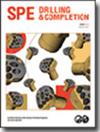Shape Memory Polymers as Lost Circulation Materials for Sealing Wide-Opened Natural Fractures
IF 1.2
4区 工程技术
Q3 ENGINEERING, PETROLEUM
引用次数: 17
Abstract
While there have been various lost circulation materials (LCMs) available in the market for treating fractures during the drilling of oil and gas wells, there is still a demand for a technology to seal large fractures. Considering limitations on the size of the particles that can be circulated through the drilling equipment, especially the bottomhole assembly, simply enlarging conventional LCM particles becomes ineffective for sealing large vugs and fractures. In this study, we use shape memory polymers (SMPs) to prepare programmed LCMs with various temporary shapes, which can transform to their permanent shapes with much larger dimensions as compared to their temporary shapes. A series of steps for thermomechanical programming of SMP is designed to trigger their expansion at the reservoir temperature. The dimensions of the programmed shapes can be an order of magnitude smaller than the ones for the original shapes, making their transport through the flowlines feasible, and bridging wide-opened fractures possible. The basic idea is that, after recovery, the SMP-based LCMs form an entangled network across a large width of fracture, and SMP particles recovered within the network, filling in the pores to form an effective sealing. We seek the capability of entangled ladders and interwoven fibers in forming a network across the fracture. A permeability plugging apparatus (PPA) is used to examine the efficiency of developed LCMs. The technique of 3D X-ray computed tomography (CT) is used to visualize the internal structure of formed plugs, enabling us to understand the mechanisms of bridging, plugging, and sealing.形状记忆聚合物作为封堵大开天然裂缝的堵漏材料
尽管市场上已经有各种堵漏材料(LCM)可用于处理油气井钻井过程中的裂缝,但仍然需要密封大裂缝的技术。考虑到可在钻井设备(尤其是井底组件)中循环的颗粒尺寸的限制,简单地扩大传统LCM颗粒对于密封大洞穴和裂缝是无效的。在这项研究中,我们使用形状记忆聚合物(SMPs)来制备具有各种临时形状的程序化LCM,与临时形状相比,这些LCM可以转变为具有更大尺寸的永久形状。SMP的热机械编程的一系列步骤被设计为在储层温度下触发它们的膨胀。编程形状的尺寸可以比原始形状的尺寸小一个数量级,这使得它们通过流线的传输是可行的,并且桥接大开口裂缝也是可能的。其基本思想是,在回收后,基于SMP的LCM在大宽度的裂缝上形成纠缠网络,SMP颗粒在网络内回收,填充孔隙以形成有效的密封。我们寻求纠缠梯和交织纤维在裂缝中形成网络的能力。渗透率封堵装置(PPA)用于检查所开发的LCM的效率。3D X射线计算机断层扫描(CT)技术用于可视化形成的塞子的内部结构,使我们能够理解桥接、堵塞和密封的机制。
本文章由计算机程序翻译,如有差异,请以英文原文为准。
求助全文
约1分钟内获得全文
求助全文
来源期刊

SPE Drilling & Completion
工程技术-工程:石油
CiteScore
4.20
自引率
7.10%
发文量
29
审稿时长
6-12 weeks
期刊介绍:
Covers horizontal and directional drilling, drilling fluids, bit technology, sand control, perforating, cementing, well control, completions and drilling operations.
 求助内容:
求助内容: 应助结果提醒方式:
应助结果提醒方式:


